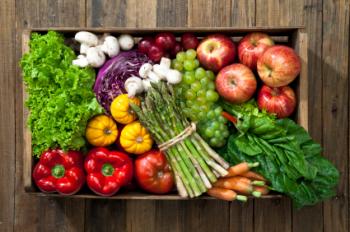Childhood obesity is not a cosmetic issue or something the child will just grow out of. Obese children tend to become obese adults, and there are many medical issues associated with obesity. Children are now taking the same type of medications as their parents to manage blood pressure, diabetes and cholesterol. This is frightening but true," Dr. Rani Whitfield, a spokesperson for the American Heart Association, told Medical News Today.
 Over the past 30 years, the rate of childhood obesity has more than doubled in children and quadrupled in adolescents.
Over the past 30 years, the rate of childhood obesity has more than doubled in children and quadrupled in adolescents.
Unfortunately, what Dr. Whitfield says is no exaggeration. Over the past 30 years, the rate of childhood obesity has more than doubled in children and quadrupled in adolescents.
The prevalence of obesity in children aged 6-11 years increased from 7% in 1980 to 18% in 2012, while the percentage of obese adolescents aged 12-19 years soared from 5% to 21% in the same period.
These significant increases have led to a rise in obesity-related health conditions among children and adolescents. A 2007 population-based survey of 5-17-year-olds revealed that around 70% of obese children and adolescents have at least one risk factor for cardiovascular disease, and it has been well established that the condition can increase the risk of musculoskeletal diseases, diabetes and cancer.
The effects of childhood obesity can persist well into adulthood, and there is global concern that if rates of childhood obesity continue to rise, so will the prevalence of related medical conditions. This will not only put the health of future generations at risk, but it will also put an enormous strain on the economy.
Such concerns have led to the launch of public health campaigns in an attempt to tackle childhood obesity, such as the Let's Move initiative launched by First Lady Michelle Obama in 2010.
But how have rates of childhood obesity reached such a high? Is enough being done to tackle the problem? And are we taking childhood obesity as seriously as we should? Medical News Today investigates.
Why have we seen such an increase in childhood obesity?
Weight status in children is determined by body mass index (BMI)-for-age percentiles. This calculates a child's weight category based on their age and BMI. A child is deemed overweight if their BMI-for-age percentile is over 85% and deemed obese if it is over 95%.
There is no doubt that the main causes of childhood obesity are an unhealthy diet and lack of physical activity.
Amanda Staiano, PhD, co-chair of the Public Affairs Committee at The Obesity Society - the leading organization dedicated to the study of obesity - told Medical News Today:
"The availability of liquid calories and empty calories, combined with a deluge of fast food and junk food advertisements, have changed the way children eat. The majority of children fail to meet the recommended 60 minutes of daily physical activity and spend a huge amount of time sitting. The way we've structured our daily lives makes it hard for children to live healthily."
It is clear that lifestyle changes have had a significant impact on childhood obesity over the past 30 years. Children used to consume one snack a day, while 1 in 5 school-age children now eats up to six snacks a day.
Food and drink portion sizes are also bigger than they were 30 years ago. In the mid-1970s, a standard sugar-sweetened drink was 13.6 ounces, while it stands at 20 ounces today.
Furthermore, the Harvard School of Public Health in Boston, MA, state a child's daily calorie intake from sugary beverages rose by 60% between 1989-2008.
Although availability of junk food and drink has decreased in schools, the Centers for Disease Control and Prevention (CDC) state that more than half of middle and high schools in the US still offer them for purchase.
And the advertising industry, health care professionals believe, has not helped rates of childhood obesity, with past studies suggesting that children exposed to junk food commercials are more likely to become obese.
Levels of physical activity have also reduced over the past 3 decades. The CDC state that last year, only 29% of high school students participated in the recommended 60 minutes of exercise a day.
The CDC state that last year, only 29% of high school students participated in the recommended 60 minutes of exercise a day.
 Gone are the days when children would run around and play for hours after school. Now, they are more likely to engage in sedentary behaviors, such as watching TV, playing computer games or using social media. Children now spend an average of 7.5 hours a day using entertainment media.
Gone are the days when children would run around and play for hours after school. Now, they are more likely to engage in sedentary behaviors, such as watching TV, playing computer games or using social media. Children now spend an average of 7.5 hours a day using entertainment media.
There are other factors that have been associated with the development of childhood obesity. Genetic disposition is one.
But health care experts believe it is primarily unhealthy diets and lack of exercise that have caused rates of childhood obesity to soar. "Although heredity may explain some of the obesity epidemic, it does not justify the explosion we've had over the last 30 years," Dr. Whitfield told us.
Parents not taking childhood obesity seriously
It seems encouraging children to eat a healthy diet and exercise more is the route to success against childhood obesity. The aforementioned Let's Move initiative is focused on doing just that. But is childhood obesity taken seriously enough for such campaigns to work?
A recent report from the CDC found that 30.2% of children and adolescents in the US misperceive their weight status. Around 48% of obese boys and 36% of obese girls consider their weight to be normal, according to the report.
A 2013 study published in the journal Maternal & Child Nutrition found that 62% of parents of obese children perceive their child as being of a healthy weight.
Dr. Eliana Perrin, associate professor of pediatrics at North Carolina Children's Hospital, told Medical News Today:
"[Parents] often do not recognize when their children are becoming overweight. Because young children at a healthy weight look skinny and because children who are overweight are becoming the norm, parents often do not realize when their children are not on a healthy track. I think they only start to worry when obesity affects their day-to-day lives."
She told us that parents need support to ensure their children adopt healthier lifestyles - something that is echoed by Staiano:
"Parents should be talking with their child's pediatrician about how to attain a healthy weight and make healthier choices with their child - even if the pediatrician doesn't bring it up. Parents are the best advocates for their children," she said, adding:
"Parents can play a role by speaking up at PTA meetings and parent-teacher conferences, advocating for healthier meals in daycares and schools, and demanding that the places children visit, such as schools and parks, are promoting healthy eating and physical activity."
Could schools do more to help tackle childhood obesity?
There is certainly an onus on schools to do more to encourage children to adopt healthy behaviors.
In the US, around 32 million students eat school meals every day, and for many of these children, school meals account for up to 50% of their daily energy intake.
"Schools have a responsibility to create a safe, supportive place where the healthy choice is the easy choice," according to Staiano.
 These guidelines require schools to have a higher offering of whole-grain rich foods, offer only fat-free or low-fat milk products, offer fruits and vegetables to all students every day of the week, limit calories based on the age of the student to ensure they receive the correct portion size, and increase focus on lowering the amount of saturated trans fat and salt in foods.
These guidelines require schools to have a higher offering of whole-grain rich foods, offer only fat-free or low-fat milk products, offer fruits and vegetables to all students every day of the week, limit calories based on the age of the student to ensure they receive the correct portion size, and increase focus on lowering the amount of saturated trans fat and salt in foods.
But schools need to do more than just offer healthy foods, according to Dr. Whitfield:
"Schools play a very critical role in encouraging healthy behaviors in children. Many children spend a significant amount of time at school where both good and bad habits can develop. Physical activity and health education should be mandatory for those in kindergarten through high school."
Staiano noted that schools are under a lot of pressure to teach core subjects but agrees that healthy living is something they should be educated about. "Schools have a responsibility to create a safe, supportive place where the healthy choice is the easy choice," she said.
But she added that encouraging children to adopt healthier lifestyles should not stop at school. Staiano noted that during school breaks, some communities offer structured summer programs that offer physical activity and healthy snacks to children.
"Neighborhood soccer and softball leagues can encourage healthy competition and physical activity as well as positive social interaction," she added. "Attractive parks with equipment catered to a variety of age ranges can provide family-friendly activity to get parents moving, too."
Fight against childhood obesity remains 'an uphill battle'
Overall, it seems childhood obesity is receiving much more attention, and health care professionals are in agreement that obesity campaigns - such as the Let's Move initiative - have helped raise awareness of the issue.
Some US states have even seen a reduction in rates of childhood obesity. A report from the CDC revealed that between 2008-11, Florida, Georgia, Missouri, New Jersey, South Dakota, and the US Virgin Islands showed a minimum decrease of 1% in their childhood obesity rates.
But although such figures show we are heading in the right direction, Staiano told us there is still a lot more work to be done.
"Childhood obesity remains at a historical high," she said. "These declines are still within the margin of error, and it is important to continue following trends to see if the trends plateau or continue to go up."
"We are certainly making some progress," added Dr. Perrin, "but given the abundance of marketing to children of unhealthy foods, the lack of easy ways to incorporate healthy activity into children's usual days, and the simultaneous unfairness of obesity stigma, it's an uphill battle."
But it seems Michelle Obama, for one, is not giving up the fight anytime soon:
"In the end, as First Lady, this isn't just a policy issue for me. This is a passion. This is my mission. I am determined to work with folks across this country to change the way a generation of kids thinks about food and nutrition."
Source: http://www.medicalnewstoday.com/






.jpg)

